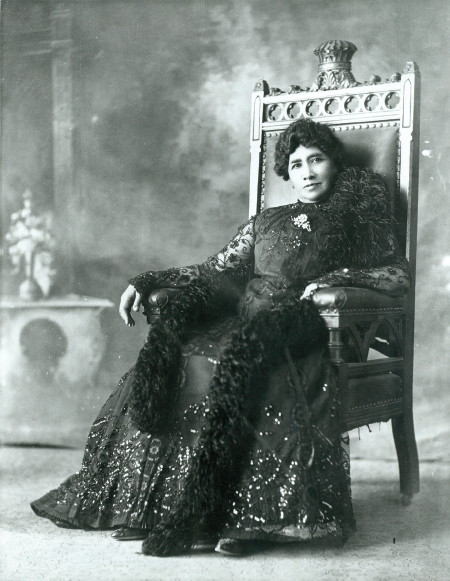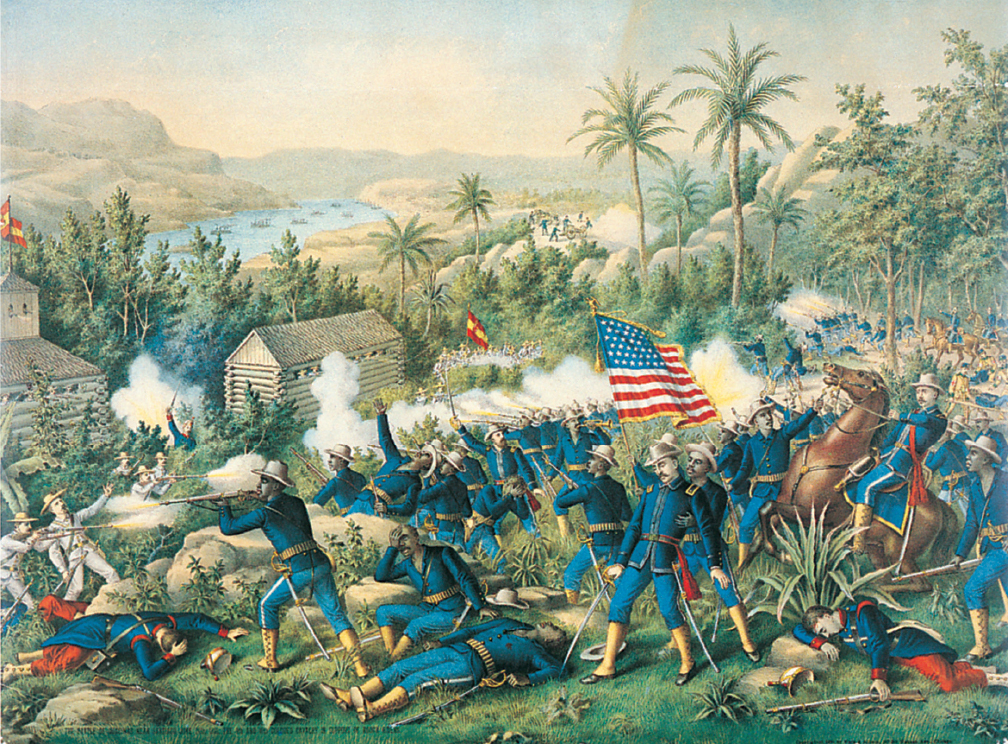America’s History: Printed Page 674
America: A Concise History: Printed Page 614
America’s History: Value Edition: Printed Page 596
The War of 1898
Events in the Caribbean presented the United States with far greater opportunities. In 1895, Cuban patriots mounted a major guerrilla war against Spain, which had lost most of its other New World territories. The Spanish commander responded by rounding up Cuban civilians into concentration camps, where as many as 200,000 died of starvation, exposure, or dysentery. In the United States, “yellow journalists” such as William Randolph Hearst turned their plight into a cause célèbre. Hearst’s coverage of Spanish atrocities fed a surge of nationalism, especially among those who feared that industrialization was causing American men to lose physical strength and valor. The government should not pass up this opportunity, said Indiana senator Albert Beveridge, to “manufacture manhood.” Congress called for Cuban independence.
President Cleveland had no interest in supporting the Cuban rebellion but worried over Spain’s failure to end it. The war disrupted trade and damaged American-owned sugar plantations on the island. Moreover, an unstable Cuba was incompatible with U.S. strategic interests, including a proposed canal whose Caribbean approaches had to be safeguarded. Taking office in 1897, President William McKinley took a tough stance. In September, a U.S. diplomat informed Spain that it must ensure an “early and certain peace” or the United States would step in. At first, this hard line seemed to work: Spain’s conservative regime fell, and a liberal government, taking office in October 1897, offered Cuba limited self-rule. But Spanish loyalists in Havana rioted against this proposal, while Cuban rebels held out for full independence.
In February 1898, Hearst’s New York Journal published a private letter in which a Spanish minister to the United States belittled McKinley. The minister, Dupuy de Lôme, resigned, but exposure of the de Lôme letter intensified Americans’ indignation toward Spain. The next week brought shocking news: the U.S. battle cruiser Maine had exploded and sunk in Havana harbor, with 260 seamen lost. “Whole Country Thrills with the War Fever,” proclaimed the New York Journal. “Remember the Maine” became a national chant. Popular passions were now a major factor in the march toward war.
McKinley assumed the sinking of the Maine had been accidental. Improbably, though, a naval board of inquiry blamed an underwater mine, fueling public outrage. (Later investigators disagreed: the more likely cause was a faulty ship design that placed explosive munitions too close to coal bunkers, which were prone to fire.) No evidence linked Spain to the purported mine, but if a mine sank the Maine, then Spain was responsible for not protecting the ship.
Business leaders became impatient, believing war was preferable to an unending Cuban crisis. On March 27, McKinley cabled an ultimatum to Madrid: an immediate ceasefire in Cuba for six months and, with the United States mediating, peace negotiations with the rebels. Spain, while desperate to avoid war, balked at the added demand that mediation must result in Cuban independence. On April 11, McKinley asked Congress for authority to intervene in Cuba “in the name of civilization, [and] in behalf of endangered American interests.”
Historians long referred to the ensuing fight as the Spanish-American War, but because that name ignores the central role of Cuban revolutionaries, many historians now call the three-way conflict the War of 1898. Though Americans widely admired Cubans’ aspirations for freedom, the McKinley administration defeated a congressional attempt to recognize the rebel government. In response, Senator Henry M. Teller of Colorado added an amendment to the war bill, disclaiming any intention by the United States to occupy Cuba. The Teller Amendment reassured Americans that their country would uphold democracy abroad as well as at home. McKinley’s expectations differed. He wrote privately, “We must keep all we get; when the war is over we must keep what we want.”
On April 24, 1898, Spain declared war on the United States. The news provoked full-blown war fever. Across the country, young men enlisted for the fight. Theodore Roosevelt, serving in the War Department, resigned to become lieutenant colonel of a cavalry regiment. Recruits poured into makeshift bases around Tampa, Florida, where confusion reigned. Rifles failed to arrive; food was bad, sanitation worse. No provision had been made for getting troops to Cuba, so the government hastily collected a fleet of yachts and commercial boats. Fortunately, the regular army was a disciplined, professional force; its 28,000 seasoned troops provided a nucleus for 200,000 volunteers. The navy was in better shape: Spain had nothing to match America’s seven battleships and armored cruisers. The Spanish admiral bitterly predicted that his fleet would “like Don Quixote go out to fight windmills and come back with a broken head.”
The first, decisive military engagement took place in the Pacific. This was the handiwork of Theodore Roosevelt, who, in his government post, had gotten the intrepid Commodore George Dewey appointed commander of the Pacific fleet. In the event of war, Dewey had instructions to sail immediately for the Spanish-owned Philippines. When war was declared, Roosevelt confronted his surprised superior and pressured him into validating Dewey’s instructions. On May 1, 1898, American ships cornered the Spanish fleet in Manila Bay and destroyed it. Manila, the Philippine capital, fell on August 13. “We must on no account let the [Philippines] go,” declared Senator Henry Cabot Lodge. McKinley agreed. The United States now had a major foothold in the western Pacific.

Dewey’s victory directed policymakers’ attention to Hawaii. Nominally independent, these islands had long been subject to U.S. influence, including a horde of resident American sugarcane planters. An 1876 treaty between the United States and the island’s monarch gave Hawaiian sugar free access to the American market, without tariff payments, and Hawaii pledged to sign no such agreement with any other power. When this treaty was renewed in 1887, Hawaii also granted a long-coveted lease for a U.S. naval base at Pearl Harbor. Four years later, succeeding her brother as Hawaii’s monarch, Queen Liliuokalani made known her frustration with these treaties. In response, an Annexation Club of U.S.-backed planters organized secretly and in 1892, with the help of U.S. Marines, overthrew the queen and then negotiated a treaty of annexation. Grover Cleveland, however, rejected it when he entered office, declaring that it would violate America’s “unbroken tradition” against acquiring territory overseas.
Dewey’s victory in Manila delivered what the planters wanted: Hawaii acquired strategic value as a halfway station to the Philippines. In July 1898, Congress voted for annexation, over the protests of Hawaii’s deposed queen. “Oh, honest Americans,” she pleaded, “as Christians hear me for my down-trodden people! Their form of government is as dear to them as yours is precious to you. Quite as warmly as you love your country, so they love theirs.” But to the great powers, Hawaii was not a country. One congressman dismissed Hawaii’s monarchy as “absurd, grotesque, tottering”; the “Aryan race,” he declared, would “rescue” the islands from it.

|
To see a longer excerpt from Queen Liliuokalani’s appeal, along with other primary sources from this period, see Sources for America’s History. |
Further U.S. annexations took on their own logic. The navy pressed for another coaling base in the central Pacific; that meant Guam, a Spanish island in the Marianas. A strategic base was needed in the Caribbean; that meant Puerto Rico. By early summer, before U.S. troops had fired a shot in Cuba, McKinley’s broader war aims were crystallizing.
In Cuba, Spanish forces were depleted by the long guerrilla war. Though poorly trained and equipped, American forces had the advantages of a demoralized foe and knowledgeable Cuban allies. The main battle occurred on July 1 at San Juan Hill, near Santiago, where the Spanish fleet was anchored. Roosevelt’s Rough Riders took the lead, but four African American regiments bore the brunt of the fighting. Observers credited much of the victory to the “superb gallantry” of these soldiers. Spanish troops retreated to a well-fortified second line, but U.S. forces were spared the test of a second assault. On July 3, the Spanish fleet in Santiago harbor tried a desperate run through the American blockade and was destroyed. Days later, Spanish forces surrendered. American combat casualties had been few; most U.S. soldiers’ deaths had resulted from malaria and yellow fever.

IDENTIFY CAUSES
Question
Why did the United States go to war against Spain in 1898, and what led to U.S. victory?